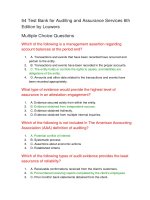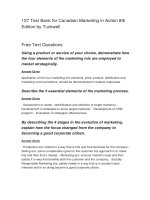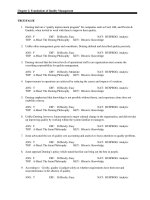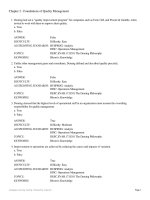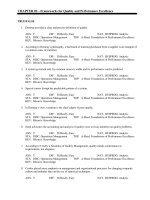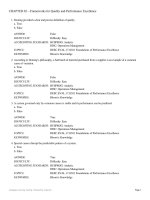Test bank for quality and performance excellence 8th edition by evans
Bạn đang xem bản rút gọn của tài liệu. Xem và tải ngay bản đầy đủ của tài liệu tại đây (229.15 KB, 28 trang )
Test Bank for Quality and Performance Excellence 8th Edition by Evans
Full
file at />CHAPTER 01—Foundations of Quality and Performance Excellence
1. The view of quality as the satisfaction of customer needs is often called fitness for use.
a. True
b. False
ANSWER:
True
DIFFICULTY:
Difficulty: Easy
ACCREDITING STANDARDS: BUSPROG: Analytic
DISC: Operations Management
TOPICS:
DESC.EVAL.17.01.01 Quality and Performance Excellence
KEYWORDS:
Bloom's: Knowledge
2. Since quality relates to goods or services, both only for-profit and non-profit organizations can benefit from adopting
performance excellence procedures.
a. True
b. False
ANSWER:
True
DIFFICULTY:
Difficulty: Easy
ACCREDITING STANDARDS: BUSPROG: Analytic
DISC: Operations Management
TOPICS:
DESC.EVAL.17.01.01 Quality and Performance Excellence
KEYWORDS:
Bloom's: Knowledge
3. “Scientific management” involved skilled craftspeople who served both as manufacturers and inspectors, building
quality into their products.
a. True
b. False
ANSWER:
False
DIFFICULTY:
Difficulty: Easy
ACCREDITING STANDARDS: BUSPROG: Analytic
DISC: Operations Management
TOPICS:
DESC.EVAL.17.01.03 A Brief History
KEYWORDS:
Bloom's: Knowledge
4. After World War II, the first country to adopt quality initiatives and improvement in industry was Japan.
a. True
b. False
ANSWER:
True
DIFFICULTY:
Difficulty: Easy
ACCREDITING STANDARDS: BUSPROG: Analytic
DISC: Operations Management
TOPICS:
DESC.EVAL.17.01.03 A Brief History
KEYWORDS:
Bloom's: Knowledge
Cengage Learning Testing, Powered by Cognero
Full file at />
Page 1
Test Bank for Quality and Performance Excellence 8th Edition by Evans
Full
file at />CHAPTER 01—Foundations of Quality and Performance Excellence
5. The Deming Prize was constituted by the United States to raise awareness of quality and recognize national role
models.
a. True
b. False
ANSWER:
True
DIFFICULTY:
Difficulty: Easy
ACCREDITING STANDARDS: BUSPROG: Analytic
DISC: Operations Management
TOPICS:
DESC.EVAL.17.01.03 A Brief History
KEYWORDS:
Bloom's: Knowledge
6. A successful organization is one which integrates quality principles with its mundane daily work activities.
a. True
b. False
ANSWER:
True
DIFFICULTY:
Difficulty: Easy
ACCREDITING STANDARDS: BUSPROG: Analytic
DISC: Operations Management
TOPICS:
DESC.EVAL.17.01.04 Quality in Organizations
KEYWORDS:
Bloom's: Knowledge
7. In quality control, tolerances are unacceptable deviations from the values assigned to the targets.
a. True
b. False
ANSWER:
False
DIFFICULTY:
Difficulty: Easy
ACCREDITING STANDARDS: BUSPROG: Analytic
DISC: Operations Management
TOPICS:
DESC.EVAL.17.01.04 Quality in Organizations
KEYWORDS:
Bloom's: Knowledge
8. The five dimensions of service quality include reliability, assurance, tangibles, empathy, and responsiveness.
a. True
b. False
ANSWER:
True
DIFFICULTY:
Difficulty: Easy
ACCREDITING STANDARDS: BUSPROG: Analytic
DISC: Operations Management
TOPICS:
DESC.EVAL.17.01.04 Quality in Organizations
KEYWORDS:
Bloom's: Knowledge
Cengage Learning Testing, Powered by Cognero
Full file at />
Page 2
Test Bank for Quality and Performance Excellence 8th Edition by Evans
Full
file at />CHAPTER 01—Foundations of Quality and Performance Excellence
9. A difference between service and manufacturing is that manufacturing is performed away from the customer
whereas customers are involved in the service process.
a. True
b. False
ANSWER:
True
DIFFICULTY:
Difficulty: Easy
ACCREDITING STANDARDS: BUSPROG: Analytic
DISC: Operations Management
TOPICS:
DESC.EVAL.17.01.04 Quality in Organizations
KEYWORDS:
Bloom's: Knowledge
10. Not-for-profit organizations are adopting quality principles because of their impact on the bottom line.
a. True
b. False
ANSWER:
False
DIFFICULTY:
Difficulty: Easy
ACCREDITING STANDARDS: BUSPROG: Analytic
DISC: Operations Management
TOPICS:
DESC.EVAL.17.01.04 Quality in Organizations
KEYWORDS:
Bloom's: Knowledge
11. From a total quality perspective, all strategic decisions a company makes are “customerdriven.”
a. True
b. False
ANSWER:
True
DIFFICULTY:
Difficulty: Easy
ACCREDITING STANDARDS: BUSPROG: Analytic
DISC: Operations Management
TOPICS:
DESC.EVAL.17.01.05 Principles and Practices of Total Quality and Performance
Excellence
KEYWORDS:
Bloom's: Knowledge
Cengage Learning Testing, Powered by Cognero
Full file at />
Page 3
Test Bank for Quality and Performance Excellence 8th Edition by Evans
Full
file at />CHAPTER 01—Foundations of Quality and Performance Excellence
12. Total Quality views everyone inside the enterprise as a customer of an internal or external supplier and a supplier
of an external or internal customer.
a. True
b. False
ANSWER:
True
DIFFICULTY:
Difficulty: Easy
ACCREDITING STANDARDS: BUSPROG: Analytic
DISC: Operations Management
TOPICS:
DESC.EVAL.17.01.05 Principles and Practices of Total Quality and Performance
Excellence
KEYWORDS:
Bloom's: Knowledge
13. Employee engagement is manifest by empowerment.
a. True
b. False
ANSWER:
True
DIFFICULTY:
Difficulty: Easy
ACCREDITING STANDARDS: BUSPROG: Analytic
DISC: Operations Management
TOPICS:
DESC.EVAL.17.01.05 Principles and Practices of Total Quality and Performance
Excellence
KEYWORDS:
Bloom's: Knowledge
14. Competitive behavior—one person against another or one group against another—is contrary to the basic principles
of TQ.
a. True
b. False
ANSWER:
True
DIFFICULTY:
Difficulty: Easy
ACCREDITING STANDARDS: BUSPROG: Analytic
DISC: Operations Management
TOPICS:
DESC.EVAL.17.01.05 Principles and Practices of Total Quality and Performance
Excellence
KEYWORDS:
Bloom's: Knowledge
Cengage Learning Testing, Powered by Cognero
Full file at />
Page 4
Test Bank for Quality and Performance Excellence 8th Edition by Evans
Full
file at />CHAPTER 01—Foundations of Quality and Performance Excellence
15. The traditional way of viewing an organization is by surveying the horizontal dimension—keeping an eye on an
organization chart.
a. True
b. False
ANSWER:
False
DIFFICULTY:
Difficulty: Easy
ACCREDITING STANDARDS: BUSPROG: Analytic
DISC: Operations Management
TOPICS:
DESC.EVAL.17.01.05 Principles and Practices of Total Quality and Performance
Excellence
KEYWORDS:
Bloom's: Knowledge
16. In terms of total quality management, “continuous improvement” refers only to breakthrough improvement.
a. True
b. False
ANSWER:
False
DIFFICULTY:
Difficulty: Easy
ACCREDITING STANDARDS: BUSPROG: Analytic
DISC: Operations Management
TOPICS:
DESC.EVAL.17.01.05 Principles and Practices of Total Quality and Performance
Excellence
KEYWORDS:
Bloom's: Knowledge
17. According to Noriaki Kano’s three classes of needs, the required safety features in an automobile are an example
of a satisfier.
a. True
b. False
ANSWER:
False
DIFFICULTY:
Difficulty: Easy
ACCREDITING STANDARDS: BUSPROG: Analytic
DISC: Operations Management
TOPICS:
DESC.EVAL.17.01.05 Principles and Practices of Total Quality and Performance
Excellence
KEYWORDS:
Bloom's: Knowledge
Cengage Learning Testing, Powered by Cognero
Full file at />
Page 5
Test Bank for Quality and Performance Excellence 8th Edition by Evans
Full
file at />CHAPTER 01—Foundations of Quality and Performance Excellence
18. The fundamental objective of a supply chain is to provide the right product in the right quantity at the right place at
the right time.
a. True
b. False
ANSWER:
True
DIFFICULTY:
Difficulty: Easy
ACCREDITING STANDARDS: BUSPROG: Analytic
DISC: Operations Management
TOPICS:
DESC.EVAL.17.01.05 Principles and Practices of Total Quality and Performance
Excellence
KEYWORDS:
Bloom's: Knowledge
19. A firm that is characterized by flexibility and short cycle times is considered to be agile.
a. True
b. False
ANSWER:
True
DIFFICULTY:
Difficulty: Easy
ACCREDITING STANDARDS: BUSPROG: Analytic
DISC: Operations Management
TOPICS:
DESC.EVAL.17.01.05 Principles and Practices of Total Quality and Performance
Excellence
KEYWORDS:
Bloom's: Knowledge
20. Agency theory views the management system as one based on social and human values, whereas total quality is
based on an economic perspective.
a. True
b. False
ANSWER:
False
DIFFICULTY:
Difficulty: Easy
ACCREDITING STANDARDS: BUSPROG: Analytic
DISC: Operations Management
TOPICS:
DESC.EVAL.17.01.06 TQ and Agency Theory
KEYWORDS:
Bloom's: Knowledge
Cengage Learning Testing, Powered by Cognero
Full file at />
Page 6
Test Bank for Quality and Performance Excellence 8th Edition by Evans
Full
file at />CHAPTER 01—Foundations of Quality and Performance Excellence
21. Agency theory suggests that information may be concealed to advance self-interests.
a. True
b. False
ANSWER:
True
DIFFICULTY:
Difficulty: Easy
ACCREDITING STANDARDS: BUSPROG: Analytic
DISC: Operations Management
TOPICS:
DESC.EVAL.17.01.06 TQ and Agency Theory
KEYWORDS:
Bloom's: Knowledge
22. Agency theory assumes that risks are not to be minimized and shared between the two parties.
a. True
b. False
ANSWER:
False
DIFFICULTY:
Difficulty: Easy
ACCREDITING STANDARDS: BUSPROG: Analytic
DISC: Operations Management
TOPICS:
DESC.EVAL.17.01.06 TQ and Agency Theory
KEYWORDS:
Bloom's: Knowledge
23. Leaders in agency theory provide a quality vision and play a strategic role in the organization.
a. True
b. False
ANSWER:
False
DIFFICULTY:
Difficulty: Easy
ACCREDITING STANDARDS: BUSPROG: Analytic
DISC: Operations Management
TOPICS:
DESC.EVAL.17.01.06 TQ and Agency Theory
KEYWORDS:
Bloom's: Knowledge
24. In the organismic model of organizations, organizations are considered to be autonomous entities.
a. True
b. False
ANSWER:
False
DIFFICULTY:
Difficulty: Easy
ACCREDITING STANDARDS: BUSPROG: Analytic
DISC: Operations Management
TOPICS:
DESC.EVAL.17.01.07 TQ and Organizational Models
KEYWORDS:
Bloom's: Knowledge
Cengage Learning Testing, Powered by Cognero
Full file at />
Page 7
Test Bank for Quality and Performance Excellence 8th Edition by Evans
Full
file at />CHAPTER 01—Foundations of Quality and Performance Excellence
25. In the organismic model of organizations, work is reduced to elementary tasks with a focus on efficiency, conformity,
and compliance.
a. True
b. False
ANSWER:
False
DIFFICULTY:
Difficulty: Easy
ACCREDITING STANDARDS: BUSPROG: Analytic
DISC: Operations Management
TOPICS:
DESC.EVAL.17.01.07 TQ and Organizational Models
KEYWORDS:
Bloom's: Knowledge
26. The mechanical organizational model assumes that systems goals such as the need to survive displace performance
goals, such as profit.
a. True
b. False
ANSWER:
False
DIFFICULTY:
Difficulty: Easy
ACCREDITING STANDARDS: BUSPROG: Analytic
DISC: Operations Management
TOPICS:
DESC.EVAL.17.01.07 TQ and Organizational Models
KEYWORDS:
Bloom's: Knowledge
27. The organismic model of organizations views an organization as a tool or a machine designed solely to create profits
for its owners.
a. True
b. False
ANSWER:
False
DIFFICULTY:
Difficulty: Easy
ACCREDITING STANDARDS: BUSPROG: Analytic
DISC: Operations Management
TOPICS:
DESC.EVAL.17.01.07 TQ and Organizational Models
KEYWORDS:
Bloom's: Knowledge
Cengage Learning Testing, Powered by Cognero
Full file at />
Page 8
Test Bank for Quality and Performance Excellence 8th Edition by Evans
Full
file at />CHAPTER 01—Foundations of Quality and Performance Excellence
28. In the cultural organizational model, managers relinquish control and share power in order to meet the needs of the
many individuals.
a. True
b. False
ANSWER:
True
DIFFICULTY:
Difficulty: Easy
ACCREDITING STANDARDS: BUSPROG: Analytic
DISC: Operations Management
TOPICS:
DESC.EVAL.17.01.07 TQ and Organizational Models
KEYWORDS:
Bloom's: Knowledge
29. In the cultural organizational model, learning needs are driven by adaptation to environmental forces instead of in
response to individual needs.
a. True
b. False
ANSWER:
False
DIFFICULTY:
Difficulty: Easy
ACCREDITING STANDARDS: BUSPROG: Analytic
DISC: Operations Management
TOPICS:
DESC.EVAL.17.01.07 TQ and Organizational Models
KEYWORDS:
Bloom's: Knowledge
30. The term _____ refers to an integrated approach to organizational performance management that results in delivery
of ever-improving value to customers and stakeholders, contributing to organizational sustainability.
a. fitness for use
b. performance excellence
c. gap analysis
d. accreditation
ANSWER:
b
DIFFICULTY:
Difficulty: Easy
ACCREDITING STANDARDS: BUSPROG: Analytic
DISC: Operational Management
TOPICS:
DESC.EVAL.17.01.01 Quality and Performance Excellence
KEYWORDS:
Bloom's: Knowledge
Cengage Learning Testing, Powered by Cognero
Full file at />
Page 9
Test Bank for Quality and Performance Excellence 8th Edition by Evans
Full
file at />CHAPTER 01—Foundations of Quality and Performance Excellence
31. Frederick W. Taylor’s concept of _____ greatly influenced the nature of quality in manufacturing organizations.
a. scientific management
b. the Hawthorne effect
c. Theory X
d. the observer-expectancy effect
ANSWER:
a
DIFFICULTY:
Difficulty: Easy
ACCREDITING STANDARDS: BUSPROG: Analytic
DISC: Operations Management
TOPICS:
DESC.EVAL.17.01.03 A Brief History
KEYWORDS:
Bloom's: Knowledge
32. _____ introduced statistical quality control to Japanese workers after World War II as part of General MacArthur’s
rebuilding program.
a. Noriaki Kano
b. F.W. Taylor
c. Malcolm Baldrige and Henry Ford
d. Edwards Deming and Joseph Juran
ANSWER:
d
DIFFICULTY:
Difficulty: Easy
ACCREDITING STANDARDS: BUSPROG: Analytic
DISC: Operations Management
TOPICS:
DESC.EVAL.17.01.03 A Brief History
KEYWORDS:
Bloom's: Knowledge
33. The prize constituted by Japan to recognize quality initiatives in business is named after _____.
a. Edwards Deming
b. Malcolm Baldrige
c. Frederick Taylor
d. Noriaki Kano
ANSWER:
a
DIFFICULTY:
Difficulty: Easy
ACCREDITING STANDARDS: BUSPROG: Analytic
DISC: Operations Management
TOPICS:
DESC.EVAL.17.01.03 A Brief History
KEYWORDS:
Bloom's: Knowledge
Cengage Learning Testing, Powered by Cognero
Full file at />
Page 10
Test Bank for Quality and Performance Excellence 8th Edition by Evans
Full
file at />CHAPTER 01—Foundations of Quality and Performance Excellence
34. In 1987, Congress established the _____ to raise awareness of quality and recognize national role models, spawning
a remarkable interest in quality among American businesses.
a. President’s Quality Award
b. Baldrige Award
c. Deming Prize
d. Peak Performance Award
ANSWER:
b
DIFFICULTY:
Difficulty: Easy
ACCREDITING STANDARDS: BUSPROG: Analytic
DISC: Operations Management
TOPICS:
DESC.EVAL.17.01.03 A Brief History
KEYWORDS:
Bloom's: Knowledge
35. In an ancillary manufacturing unit, the bolt manufacturing section has a value of 0.095 as the target, 0.005 as the
tolerance. Which of the following is the acceptable range of values in production?
a. Between 9.500 and 1.005
b. Between 0.009 and 0.001
c. Between 0.900 and 0.010
d. Between 0.090 and 0.100
ANSWER:
d
DIFFICULTY:
Difficulty: Moderate
ACCREDITING STANDARDS: BUSPROG: Analytic
DISC: Operations Management
TOPICS:
DESC.EVAL.17.01.04 Quality in Organizations
KEYWORDS:
Bloom's: Knowledge
36. As part of the evolving understanding of quality management, many began to use the term _____ to contrast the
difference between managing for quality in all organizational processes and focusing solely on manufacturing quality
.
a. micro-quality
b. strategic quality
c. Lead Q
d. Big Q
ANSWER:
d
DIFFICULTY:
Difficulty: Easy
ACCREDITING STANDARDS: BUSPROG: Analytic
DISC: Operations Management
TOPICS:
DESC.EVAL.17.01.03 A Brief History
KEYWORDS:
Bloom's: Knowledge
Cengage Learning Testing, Powered by Cognero
Full file at />
Page 11
Test Bank for Quality and Performance Excellence 8th Edition by Evans
Full
file at />CHAPTER 01—Foundations of Quality and Performance Excellence
37. _____ refer(s) to a product’s primary operating characteristics.
a. Benefits
b. Conformance
c. Aesthetics
d. Performance
ANSWER:
d
DIFFICULTY:
Difficulty: Easy
ACCREDITING STANDARDS: BUSPROG: Analytic
DISC: Operations Management
TOPICS:
DESC.EVAL.17.01.04 Quality in Organizations
KEYWORDS:
Bloom's: Knowledge
38. _____ refers to the degree to which physical and performance characteristics of a product match preestablished
standards.
a. Reliability
b. Conformance
c. Features
d. Aesthetics
ANSWER:
b
DIFFICULTY:
Difficulty: Easy
ACCREDITING STANDARDS: BUSPROG: Analytic
DISC: Operations Management
TOPICS:
DESC.EVAL.17.01.04 Quality in Organizations
KEYWORDS:
Bloom's: Knowledge
39. _____ is the subjective assessment of a product resulting from image, advertising, or brand names.
a. Perceived quality
b. Reliability
c. Performance
d. Aesthetics
ANSWER:
a
DIFFICULTY:
Difficulty: Easy
ACCREDITING STANDARDS: BUSPROG: Analytic
DISC: Operations Management
TOPICS:
DESC.EVAL.17.01.04 Quality in Organizations
KEYWORDS:
Bloom's: Knowledge
Cengage Learning Testing, Powered by Cognero
Full file at />
Page 12
Test Bank for Quality and Performance Excellence 8th Edition by Evans
Full
file at />CHAPTER 01—Foundations of Quality and Performance Excellence
40. With respect to the quality dimensions of manufactured products, _____ refer(s) to a product’s primary operating
characteristics.
a. reliability
b. features
c. performance
d. durability
ANSWER:
c
DIFFICULTY:
Difficulty: Easy
ACCREDITING STANDARDS: BUSPROG: Analytic
DISC: Operations Management
TOPICS:
DESC.EVAL.17.01.04 Quality in Organizations
KEYWORDS:
Bloom's: Knowledge
41. With respect to the quality dimensions of manufactured products, _____ refer(s) to the probability of a product’s
surviving over a specified period of time under stated conditions of use.
a. aesthetics
b. serviceability
c. features
d. reliability
ANSWER:
d
DIFFICULTY:
Difficulty: Moderate
ACCREDITING STANDARDS: BUSPROG: Analytic
DISC: Operations Management
TOPICS:
DESC.EVAL.17.01.04 Quality in Organizations
KEYWORDS:
Bloom's: Knowledge
42. With respect to the quality dimensions of manufactured products, _____refer(s) to the amount of use one gets from
a product before it physically deteriorates or until replacement is preferable.
a. durability
b. aesthetics
c. features
d. serviceability
ANSWER:
a
DIFFICULTY:
Difficulty: Easy
ACCREDITING STANDARDS: BUSPROG: Analytic
DISC: Operations Management
TOPICS:
DESC.EVAL.17.01.04 Quality in Organizations
KEYWORDS:
Bloom's: Knowledge
Cengage Learning Testing, Powered by Cognero
Full file at />
Page 13
Test Bank for Quality and Performance Excellence 8th Edition by Evans
Full
file at />CHAPTER 01—Foundations of Quality and Performance Excellence
43. With respect to the quality dimensions of manufactured products, _____ refer(s) to the ability to repair a product
quickly and easily.
a. durability
b. serviceability
c. conformance
d. features
ANSWER:
b
DIFFICULTY:
Difficulty: Easy
ACCREDITING STANDARDS: BUSPROG: Analytic
DISC: Operations Management
TOPICS:
DESC.EVAL.17.01.04 Quality in Organizations
KEYWORDS:
Bloom's: Knowledge
44. With respect to the quality dimensions of manufactured products, _____ deals with how a product looks, feels,
sounds, tastes, or smells.
a. serviceability
b. durability
c. performance
d. aesthetics
ANSWER:
d
DIFFICULTY:
Difficulty: Easy
ACCREDITING STANDARDS: BUSPROG: Analytic
DISC: Operations Management
TOPICS:
DESC.EVAL.17.01.04 Quality in Organizations
KEYWORDS:
Bloom's: Knowledge
45. Which of the following is true of the service sector as opposed to manufacturing firms?
a. Service firms usually maintain inventory registers.
b. A service firm considers that all customer needs are the same.
c. The output of a service firm is intangible.
d. Service firms require a physical production site.
ANSWER:
c
DIFFICULTY:
Difficulty: Easy
ACCREDITING STANDARDS: BUSPROG: Analytic
DISC: Operations Management
TOPICS:
DESC.EVAL.17.01.04 Quality in Organizations
KEYWORDS:
Bloom's: Knowledge
Cengage Learning Testing, Powered by Cognero
Full file at />
Page 14
Test Bank for Quality and Performance Excellence 8th Edition by Evans
Full
file at />CHAPTER 01—Foundations of Quality and Performance Excellence
46. Which of the following is an example of a service provider?
a. A steel plant
b. A clothing manufacturer
c. A pharmaceutical company
d. A bank
ANSWER:
d
DIFFICULTY:
Difficulty: Moderate
ACCREDITING STANDARDS: BUSPROG: Analytic
DISC: Operations Management
TOPICS:
DESC.EVAL.17.01.04 Quality in Organizations
KEYWORDS:
Bloom's: Comprehension
47. _____ is an important dimension associated with service quality.
a. Aesthetics
b. Serviceability
c. Durability
d. Accuracy
ANSWER:
d
DIFFICULTY:
Difficulty: Easy
ACCREDITING STANDARDS: BUSPROG: Analytic
DISC: Operations Management
TOPICS:
DESC.EVAL.17.01.04 Quality in Organizations
KEYWORDS:
Bloom's: Knowledge
48. The _____ is the highest award given to executive branch agencies for management excellence.
a. President’s Quality Award
b. Malcolm Baldrige Award
c. Deming Prize
d. National Quality Improvement Award
ANSWER:
a
DIFFICULTY:
Difficulty: Easy
ACCREDITING STANDARDS: BUSPROG: Analytic
DISC: Operations Management
TOPICS:
DESC.EVAL.17.01.04 Quality in Organizations
KEYWORDS:
Bloom's: Knowledge
Cengage Learning Testing, Powered by Cognero
Full file at />
Page 15
Test Bank for Quality and Performance Excellence 8th Edition by Evans
Full
file at />CHAPTER 01—Foundations of Quality and Performance Excellence
49. Which of the following TQ principles was the TQ quality initially based on?
a. Emphasis on individual work
b. Continuous improvement
c. Employee focus
d. Quality variance
ANSWER:
b
DIFFICULTY:
Difficulty: Moderate
ACCREDITING STANDARDS: BUSPROG: Analytic
DISC: Operations Management
TOPICS:
DESC.EVAL.17.01.05 Principles and Practices of Total Quality and Performance
Excellence
KEYWORDS:
Bloom's: Knowledge
50. In 1992, in cooperation with deans of business and engineering departments of major universities, and recognized
consultants, the chairs and CEOs of nine major U.S. corporations endorsed a definition of _____ as a peoplefocused management system that aims at continual increase in customer satisfaction at continually lower real cost.
a. business process reengineering
b. a quality circle
c. total quality
d. Six Sigma management
ANSWER:
c
DIFFICULTY:
Difficulty: Easy
ACCREDITING STANDARDS: BUSPROG: Analytic
DISC: Operations Management
TOPICS:
DESC.EVAL.17.01.05 Principles and Practices of Total Quality and Performance
Excellence
KEYWORDS:
Bloom's: Knowledge
51. In a total quality environment, internal customers are the:
a. designated team members of the quality control team.
b. customers who are part of the product testing panel.
c. recipients of any work output.
d. immediate customers, but not the end users.
ANSWER:
c
DIFFICULTY:
Difficulty: Easy
ACCREDITING STANDARDS: BUSPROG: Analytic
DISC: Operations Management
TOPICS:
DESC.EVAL.17.01.05 Principles and Practices of Total Quality and Performance
Excellence
KEYWORDS:
Bloom's: Knowledge
Cengage Learning Testing, Powered by Cognero
Full file at />
Page 16
Test Bank for Quality and Performance Excellence 8th Edition by Evans
Full
file at />CHAPTER 01—Foundations of Quality and Performance Excellence
52. Customer engagement refers to:
a. organizations designing products and processes with the goal of maximizing revenue from individual
customers.
b. organizations building relationships with customers so they will continue to use their goods and services and
actively advocate for and recommend them.
c. organizations customizing product and service features to meet the needs of individual customers rather than
mass-producing products.
d. customers proactively approaching organizations in order to suggest product ideas and features for
development.
ANSWER:
b
DIFFICULTY:
Difficulty: Easy
ACCREDITING STANDARDS: BUSPROG: Analytic
DISC: Operations Management
TOPICS:
DESC.EVAL.17.01.05 Principles and Practices of Total Quality and Performance
Excellence
KEYWORDS:
Bloom's: Knowledge
53. A manager who is considered a Theory X manager is likely to believe that:
a. productivity is enhanced when employees make decisions on their own.
b. workers dislike work and require close supervision and control.
c. worker productivity improves when managers relax supervision.
d. employees are self-motivated and eager to take on challenges.
ANSWER:
b
DIFFICULTY:
Difficulty: Easy
ACCREDITING STANDARDS: BUSPROG: Analytic
DISC: Operations Management
TOPICS:
DESC.EVAL.17.01.05 Principles and Practices of Total Quality and Performance
Excellence
KEYWORDS:
Bloom's: Knowledge
Cengage Learning Testing, Powered by Cognero
Full file at />
Page 17
Test Bank for Quality and Performance Excellence 8th Edition by Evans
Full
file at />CHAPTER 01—Foundations of Quality and Performance Excellence
54. According to McGregor’s _____ , workers are selfmotivated, seek responsibility, and exhibit a high degree of
imagination and creativity at work.
a. Theory Z
b. Theory Y
c. Theory X
d. Theory Q
ANSWER:
b
DIFFICULTY:
Difficulty: Easy
ACCREDITING STANDARDS: BUSPROG: Analytic
DISC: Operations Management
TOPICS:
DESC.EVAL.17.01.05 Principles and Practices of Total Quality and Performance
Excellence
KEYWORDS:
Bloom's: Knowledge
55. Teamwork between top management and lower-level employees is called _____ teamwork.
a. vertical
b. interorganizational
c. horizontal
d. cross-functional
ANSWER:
a
DIFFICULTY:
Difficulty: Easy
ACCREDITING STANDARDS: BUSPROG: Analytic
DISC: Operations Management
TOPICS:
DESC.EVAL.17.01.05 Principles and Practices of Total Quality and Performance
Excellence
KEYWORDS:
Bloom's: Knowledge
56. Teamwork within work groups and across functional lines is called _____ teamwork.
a. cross-training
b. interorganizational
c. horizontal
d. quality circle
ANSWER:
c
DIFFICULTY:
Difficulty: Easy
ACCREDITING STANDARDS: BUSPROG: Analytic
DISC: Operations Management
TOPICS:
DESC.EVAL.17.01.05 Principles and Practices of Total Quality and Performance
Excellence
KEYWORDS:
Bloom's: Knowledge
Cengage Learning Testing, Powered by Cognero
Full file at />
Page 18
Test Bank for Quality and Performance Excellence 8th Edition by Evans
Full
file at />CHAPTER 01—Foundations of Quality and Performance Excellence
57. Partnerships with suppliers and customers are called ______ partnerships.
a. horizontal
b. cross-functional
c. vertical
d. interorganizational
ANSWER:
d
DIFFICULTY:
Difficulty: Easy
ACCREDITING STANDARDS: BUSPROG: Analytic
DISC: Operations Management
TOPICS:
DESC.EVAL.17.01.05 Principles and Practices of Total Quality and Performance
Excellence
KEYWORDS:
Bloom's: Knowledge
58. A(n) _____ is a sequence of activities that is intended to achieve some result.
a. process
b. array
c. cluster
d. symmetry
ANSWER:
a
DIFFICULTY:
Difficulty: Easy
ACCREDITING STANDARDS: BUSPROG: Analytic
DISC: Operations Management
TOPICS:
DESC.EVAL.17.01.05 Principles and Practices of Total Quality and Performance
Excellence
KEYWORDS:
Bloom's: Knowledge
59. With respect to the systems approach to management, _____ refers to looking at an organization as a whole and
building on key business attributes, including core competencies, strategic objectives, action plans, and work systems.
a. alignment
b. integration
c. sequence
d. synthesis
ANSWER:
d
DIFFICULTY:
Difficulty: Easy
ACCREDITING STANDARDS: BUSPROG: Analytic
DISC: Operations Management
TOPICS:
DESC.EVAL.17.01.05 Principles and Practices of Total Quality and Performance
Excellence
KEYWORDS:
Bloom's: Knowledge
Cengage Learning Testing, Powered by Cognero
Full file at />
Page 19
Test Bank for Quality and Performance Excellence 8th Edition by Evans
Full
file at />CHAPTER 01—Foundations of Quality and Performance Excellence
60. In the context of Noriaki Kano’s classification of customer needs, _____ refer to those needs that are expected in a
product or service.
a. satisfiers
b. delighters
c. dissatisfiers
d. exciters
ANSWER:
c
DIFFICULTY:
Difficulty: Easy
ACCREDITING STANDARDS: BUSPROG: Analytic
DISC: Operations Management
TOPICS:
DESC.EVAL.17.01.05 Principles and Practices of Total Quality and Performance
Excellence
KEYWORDS:
Bloom's: Knowledge
61. According to Noriaki Kano’s classification of customer needs, _____ are the needs that customers say they want.
a. satisfiers
b. dissatisfiers
c. delighters
d. exciters
ANSWER:
a
DIFFICULTY:
Difficulty: Easy
ACCREDITING STANDARDS: BUSPROG: Analytic
DISC: Operations Management
TOPICS:
DESC.EVAL.17.01.05 Principles and Practices of Total Quality and Performance
Excellence
KEYWORDS:
Bloom's: Knowledge
62. According to Noriaki Kano’s classification of customer needs, _____ new or innovative features that customers do
not expect in a product or service.
a. satisfiers
b. delighters
c. dissatisfiers
d. essentials
ANSWER:
b
DIFFICULTY:
Difficulty: Easy
ACCREDITING STANDARDS: BUSPROG: Analytic
DISC: Operations Management
TOPICS:
DESC.EVAL.17.01.05 Principles and Practices of Total Quality and Performance
Excellence
KEYWORDS:
Bloom's: Knowledge
Cengage Learning Testing, Powered by Cognero
Full file at />
Page 20
Test Bank for Quality and Performance Excellence 8th Edition by Evans
Full
file at />CHAPTER 01—Foundations of Quality and Performance Excellence
63. Sylvia orders a security system to be installed at her house. After placing the order, the company took three days to
install it. The time taken for the order to be delivered is referred to as:
a. execution gap.
b. cycle time.
c. performance gap.
d. turnaround time.
ANSWER:
b
DIFFICULTY:
Difficulty: Moderate
ACCREDITING STANDARDS: BUSPROG: Analytic
DISC: Operations Management
TOPICS:
DESC.EVAL.17.01.05 Principles and Practices of Total Quality and Performance
Excellence
KEYWORDS:
Bloom's: Knowledge
64. Agency theory makes the assumption that individuals in agency relationships are _____ and will always take actions
to enhance their self-interests.
a. utility-maximizers
b. negotiators
c. satisficers
d. adopters
ANSWER:
a
DIFFICULTY:
Difficulty: Easy
ACCREDITING STANDARDS: BUSPROG: Analytic
DISC: Operations Management
TOPICS:
DESC.EVAL.17.01.06 TQ and Agency Theory
KEYWORDS:
Bloom's: Knowledge
65. In agency theory, _____ is a primary mechanism used by both parties to maintain and govern the relationship.
a. autonomy
b. motivation
c. self-regulation
d. monitoring
ANSWER:
d
DIFFICULTY:
Difficulty: Easy
ACCREDITING STANDARDS: BUSPROG: Analytic
DISC: Operations Management
TOPICS:
DESC.EVAL.17.01.06 TQ and Agency Theory
KEYWORDS:
Bloom's: Knowledge
Cengage Learning Testing, Powered by Cognero
Full file at />
Page 21
Test Bank for Quality and Performance Excellence 8th Edition by Evans
Full
file at />CHAPTER 01—Foundations of Quality and Performance Excellence
66. In the _____ organizational model, work is reduced to elementary tasks with a focus on efficiency, conformity, and
compliance.
a. environmental
b. mechanistic
c. organismic
d. cultural
ANSWER:
b
DIFFICULTY:
Difficulty: Easy
ACCREDITING STANDARDS: BUSPROG: Analytic
DISC: Operations Management
TOPICS:
DESC.EVAL.17.01.07 TQ and Organizational Models
KEYWORDS:
Bloom's: Knowledge
67. The _____ model assumes that systems goals, such as the need to survive, displace performance goals, such as
profit.
a. cultural
b. mechanistic
c. organismic
d. environmental
ANSWER:
c
DIFFICULTY:
Difficulty: Easy
ACCREDITING STANDARDS: BUSPROG: Analytic
DISC: Operations Management
TOPICS:
DESC.EVAL.17.01.07 TQ and Organizational Models
KEYWORDS:
Bloom's: Knowledge
68. Total Quality shares the most similarities with the _____ organizational model.
a. cultural
b. environmental
c. organismic
d. mechanistic
ANSWER:
c
DIFFICULTY:
Difficulty: Easy
ACCREDITING STANDARDS: BUSPROG: Analytic
DISC: Operations Management
TOPICS:
DESC.EVAL.17.01.07 TQ and Organizational Models
KEYWORDS:
Bloom's: Knowledge
Cengage Learning Testing, Powered by Cognero
Full file at />
Page 22
Test Bank for Quality and Performance Excellence 8th Edition by Evans
Full
file at />CHAPTER 01—Foundations of Quality and Performance Excellence
69. The _____ model views an organization as a collection of cooperative agreements entered into by individuals with
free will.
a. mechanistic
b. environmental
c. organismic
d. cultural
ANSWER:
d
DIFFICULTY:
Difficulty: Easy
ACCREDITING STANDARDS: BUSPROG: Analytic
DISC: Operations Management
TOPICS:
DESC.EVAL.17.01.07 TQ and Organizational Models
KEYWORDS:
Bloom's: Knowledge
70. What is performance excellence?
The term “performance excellence” refers to an integrated approach to
organizational performance management that results in delivery of ever-improving
value to customers and stakeholders, contributing to organizational sustainability;
improvement of overall organizational effectiveness and capabilities; and
organizational and personal learning. Performance excellence is a characteristic of
today’s most outstanding organizations and is a requisite for providing high quality
goods and services.
DIFFICULTY:
Difficulty: Moderate
ACCREDITING STANDARDS: BUSPROG: Analytic
DISC: Operations Management
TOPICS:
DESC.EVAL.17.01.01 Quality and Performance Excellence
KEYWORDS:
Bloom's: Knowledge
ANSWER:
Cengage Learning Testing, Powered by Cognero
Full file at />
Page 23
Test Bank for Quality and Performance Excellence 8th Edition by Evans
Full
file at />CHAPTER 01—Foundations of Quality and Performance Excellence
71. Briefly describe the quality dimensions of manufactured products.
ANSWER:
Manufactured products have several quality dimensions:
1) Performance: a product’s primary operating characteristics.
2) Features: the “bells and whistles” of a product.
3) Reliability: the probability of a product’s surviving over a specified period of time
under stated conditions of use.
4) Conformance: the degree to which physical and performance characteristics of
a product match preestablished standards.
5) Durability: the amount of use one gets from a product before it physically
deteriorates or until replacement is preferable.
6) Serviceability: the ability to repair a product quickly and easily.
7) Aesthetics: how a product looks, feels, sounds, tastes, or smells.
8) Perceived quality: subjective assessment resulting from image, advertising, or
brand names.
DIFFICULTY:
Difficulty: Easy
ACCREDITING STANDARDS: BUSPROG: Analytic
DISC: Operations Management
TOPICS:
DESC.EVAL.17.01.04 Quality in Organizations
KEYWORDS:
Bloom's: Knowledge
72. Describe in brief the most important dimensions of service quality.
ANSWER:
The most important dimensions of service quality are the following:
1) Time: How much time must a customer wait?
2) Timeliness: Will a service be performed when promised?
3) Completeness: Are all items in the order included?
4) Courtesy: Do frontline employees greet each customer cheerfully?
5) Consistency: Are services delivered in the same fashion for every customer, and
every time for the same customer?
6) Accessibility and convenience: Is the service easy to obtain?
7) Accuracy: Is the service performed right the first time?
8) Responsiveness: Can service personnel react quickly and resolve unexpected
problems?
DIFFICULTY:
Difficulty: Easy
ACCREDITING STANDARDS: BUSPROG: Analytic
DISC: Operations Management
TOPICS:
DESC.EVAL.17.01.04 Quality in Organizations
KEYWORDS:
Bloom's: Knowledge
Cengage Learning Testing, Powered by Cognero
Full file at />
Page 24
Test Bank for Quality and Performance Excellence 8th Edition by Evans
Full
file at />CHAPTER 01—Foundations of Quality and Performance Excellence
73. What are the points organizations have to look into beyond product orientation to ensure service quality?
ANSWER:
Service organizations must look beyond product orientation and pay significant
attention to customer transactions and employee behavior. Several points that
service organizations should consider are as follows:
1) The quality characteristics that a firm should control may not be the obvious
ones.
2) Behavior is a quality characteristic.
3) Image is a major factor in shaping customer expectations of a service and in
setting standards by which customers evaluate that service.
4) Establishing and measuring service levels may be difficult.
5) Quality control activity may be required at times or in places where supervision
and control personnel are not present.
DIFFICULTY:
Difficulty: Moderate
ACCREDITING STANDARDS: BUSPROG: Analytic
DISC: Operations Management
TOPICS:
DESC.EVAL.17.01.04 Quality in Organizations
KEYWORDS:
Bloom's: Knowledge
74. How is empowerment related to employee engagement?
ANSWER:
Employee engagement simply means that workers have a strong emotional bond to
their organization, are actively involved in and committed to their work, feel that
their jobs are important, know that their opinions and ideas have value, and often go
beyond their immediate job responsibilities for the good of the organization.
Engagement is often manifest by empowerment, which simply means that people
have the authority to make decisions based on what they feel is right, have control
over their work, take risks and learn from mistakes, and promote change.
DIFFICULTY:
Difficulty: Moderate
ACCREDITING STANDARDS: BUSPROG: Analytic
DISC: Operations Management
TOPICS:
DESC.EVAL.17.01.05 Principles and Practices of Total Quality and Performance
Excellence
KEYWORDS:
Bloom's: Knowledge
Cengage Learning Testing, Powered by Cognero
Full file at />
Page 25
